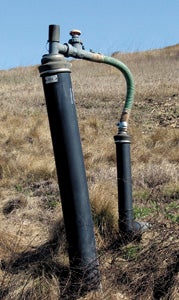Landfill temps drop
Published 9:14 pm Tuesday, April 2, 2013
The Suffolk regional landfill has been a hot topic in recent months, but temperatures there — inside Cell 5, specifically — have started to cool down recently.
Regular monitoring found temperatures in the core of Cell 5 were getting unusually high — as warm as the upper 180 degrees, landfill supervisor Scott Whitehurst said Tuesday. But they have recently begun to cool down slightly, indicating steps the Southeastern Public Service Authority has taken may be working.

A gas well on Cell 5 at the regional landfill in Suffolk owned by the Southeastern Public Service Authority. Cell 5 has had trouble with its interior temperatures for many years, landfill supervisor Scott Whitehurst said.
Decomposing trash inside the landfill generates gases — mostly methane — that heat up the mound. That’s not unusual, but temperatures that get too high can cause problems, including melting the liner under the pile of trash and allowing murky leachate — water that has filtered through the trash — to escape into the environment.
Whitehurst said the liner has never been in danger, because the temperatures at the bottom of the cell are near normal. It’s in the middle of the pile, where he believes the authority was dumping ash about 20 years ago, that temperatures are the highest.
“Right now, the liner is fine,” Whitehurst said. “There are no issues with the liner.”
The authority uses wells to pull gas from the cells. It uses some of the gas to power its own generators, sells some of it to BASF on Wilroy Road for its generators, and disposes of the rest by flaring it.
The authority has taken some steps to correct the problem at the landfill, which is bordered on the south by Route 58 and by Nansemond Parkway on the west.
Whitehurst said landfill operators would soon be putting more cover on the landfill to help prevent oxygen from getting into the pile, which speeds up decomposition and raises temperatures. Other steps include having the cell at “zero vacuum,” which also avoids oxygen getting into the cell.
Whitehurst said it would have been easier to just build a gas trench.
“Our opinion was that considering odor issues we’ve had, we don’t want to take a risk of having odor issues with an open trench,” he said. “Our last-ditch effort is going to be to put the trench in. We don’t want to waste the gas, and we don’t want to cause any odor problems.”
Whitehurst said that, considering the liner is protected, there is little risk to the public from the problem. SPSA monitors gas wells on Cell 5 monthly and reports the readings to the Environmental Protection Agency, he said.
“I feel pretty confident the temperature issue is going to be corrected,” he said.






